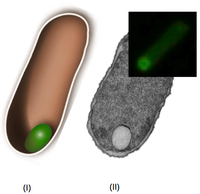Freiburg research team headed by former FRIAS fellow Stefan Schiller publishes seminal research findings in Nature journals
Both publications deal with scientific procedures that enhance the functional range of cells and could thereby ultimately enable the production of basic raw materials for the chemical industry, which is fundamental for a sustainable bio economy.
The research group around Stefan Schiller uses tailor-made proteins as elements to build Nano systems with new physical, chemical and biological properties. The sustainable and resource-saving production of these proteins takes place for example in the natural flow of energy and materials in cells. Therefore, the group is working on equipping bacteria with additional elements such as enzymes, transporters, switches and organelles.
In March 2015, the scientists, together with colleagues from the University of Freiburg, published the results of their study using protein-based ‘adaptors/connectors’ with genetically encoded interaction sites to guide the assembly and functionality of different plasmonically active gold nanoparticle architectures (see figure 1). Thereby, bio-based materials with new optic and plasmonic properties can be produced. Nanoplasmonics deal with smallest electromagnetic waves emitted from metal particles when they interact with light. Based on the same principle, Nano systems that transform light into electric energy as well as bio-based materials with new magnetic properties could be developed.
|
Figure 2 |
Organelles are the subject of another research project by Stefan Schiller’s group, together with other groups in Freiburg and Hungary. In an article published in January 2015 in Nature Materials, they were able to refute a long established paradigm: they not only revealed that organelles – the organs of cells – can be enhanced with additional functions, but also introduced an approach to intentionally “program” the de novo synthesis and self-assembly of genetically encoded amphiphilic proteins to form organelles. |
|---|
Whereas less complex cells such as bacteria cells rarely have organelles, higher cells, i.e. plant- and mammalian cells, possess a wide variety of organelles such as the nucleus, the mitochondria, lysosomes and others. Like the organs in human bodies, these organelles fulfill various functions such as the decomposition of substances or energy supply.
Stefan Schiller’s team was able to demonstrate that these organelles can be newly constituted and functionalized. So far, the prevailing assumption was that organelles can only be constituted from existing organelles. Since cell compartments of higher cells are mainly constituted from lipids, which, as secondary gene products, cannot be directly regulated by genetic control, the research group developed a new approach based on the use of amphiphile, i.e. both hydrophile and lipophile, proteins instead of lipids. Like lipids, these proteins have a hydrophilic and a hydrophobic molecule component. These characteristics allow the amphiphile proteins to independently form organelle-like compartments. In this way, these organelles can be subject of further studies for biotechnological applications and thus form the basis for new concepts and approaches in the study of biomedical processes and applications in the field of biotechnology, chemistry and pharmacy. While so far there was a lack of strategies and applications for the biosynthesis of important raw materials, they can now be produced for the chemical industry through the functional enhancement of bacteria cells.
For the realization of these ideas, Stefan Schiller has received a prestigious research prize (Biotechnologie 2020+), worth approx. 3.4 million Euros, by the German Federal Ministry of Education and Research in 2014.
Figure 1: The schematic models and electron microscope images show defined architectures consisting of proteins (green in the model) and gold nanoparticles.
Figure 2: Scheme, electron microscopy image, and fluorescence image of organelles
Publications:
- Matthias C. Huber, Andreas Schreiber, Philipp von Olshausen, Balázs R. Varga, Oliver Kretz, Barbara Joch, Sabine Barnert, Rolf Schubert, Stefan Eimer, Péter Kele & Stefan M. Schiller: Designer amphiphilic proteins as building blocks for the intracellular formation of organelle-like compartments. Nature Materials 14, 125–132 (2015). doi:10.1038/nmat4118
- Andreas Schreiber, Matthias C. Huber, Helmut Cölfen & Stefan M. Schiller: Molecular protein adaptor with genetically encoded interaction sites guiding the hierarchical assembly of plasmonically active nanoparticle architectures. Nature Communications 6, Article number: 6705 (2015). doi:10.1038/ncomms7705 www.nature.com/ncomms/2015/150327/ncomms7705/metrics
04/2015


